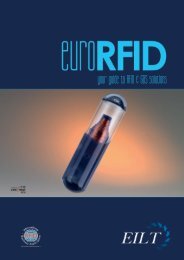Gene Fedors Vice President, Education Programs RFID Technical ...
Gene Fedors Vice President, Education Programs RFID Technical ...
Gene Fedors Vice President, Education Programs RFID Technical ...
You also want an ePaper? Increase the reach of your titles
YUMPU automatically turns print PDFs into web optimized ePapers that Google loves.
METRO : A FRESH NEW YEAR FOR <strong>RFID</strong><br />
This highlight is followed by the<br />
participation of the METRO Group in the 2006<br />
CeBIT. In an area of about 2,800 square meters,<br />
the Future Store Initiative and its partners will<br />
present possible applications of <strong>RFID</strong> technology<br />
in various areas of everyday life. Impressive<br />
exhibits will show how <strong>RFID</strong> can support<br />
consumers during shopping, at home and in their<br />
leisure activities. In addition, a look behind the<br />
scenes will provide insight on how the retail<br />
sector uses the technology in the fields of<br />
warehouse management and logistics. “The<br />
participation in CeBIT underscores our position as<br />
the industry’s innovation leader. We are the first<br />
retailer to present <strong>RFID</strong> in this form at the world’s<br />
largest IT fair,” said Zygmunt Mierdorf, Member of<br />
the Management Board of METRO Group.<br />
FACING THE DYNAMICS OF GLOBAL<br />
COMMERCE<br />
Hamburg (Germany) is home to the<br />
world’s most modern container terminal<br />
Containers are the common<br />
denominator. They hold goods that are<br />
transported across thousands of miles and<br />
multiple oceans to their destination – by ship, rail<br />
or truck. Global commerce has grown fast over<br />
the past few years. The company Hamburger<br />
Hafen und Logistik Aktiengesellschaft (HHLA) has<br />
adjusted to this rapid growth. One of the leading<br />
maritime shipping companies, HHLA opened the<br />
world’s most modern container terminal in the<br />
south of Hamburg in June 2002.<br />
The Container Terminal Altenwerder (CTA)<br />
achieves top figures in area and employee<br />
productivity as well as cargo handling. The use of<br />
<strong>RFID</strong> plays a key role in this respect. “There are<br />
three main areas of application: access control,<br />
generation of the pick-up order and automatic<br />
transport management from or to the container<br />
site,” says Jörg Sabellek, Head of Distribution of<br />
the subsidiary HHLA Rhenus Logistics Altenwerder<br />
GmbH & Co. KG. Each truck driver regularly<br />
returning to the terminal receives a so-called<br />
Trucker Card, which is linked to important data<br />
such as the driver’s name, his company and the<br />
license plate of the vehicle. This personal card<br />
grants access privileges to the container yard.<br />
The driver’s order is registered by a CTA<br />
employee. The IT system automatically links the<br />
order with the data on the Trucker Card. As a<br />
result, the cardholder is authorized to drive into<br />
the corresponding container storage area. Once<br />
the driver has reached the container stack in<br />
question, he holds the card up to a delivery gate.<br />
The system recognizes the order data;<br />
subsequently, an automated crane transports<br />
the desired container to the truck.<br />
There is another important area in which<br />
<strong>RFID</strong> is used: unmanned transport vehicles carry<br />
the containers from the ship to the storage area<br />
and vice versa. The so-called automatic guided<br />
vehicles (AGV) are equipped with antennae,<br />
which communicate with about 12,000<br />
transponders integrated into the asphalt. “A fleet<br />
management system determines the optimal<br />
route and the transponders show the way,” says<br />
Gerlinde John, Head of Terminal Development at<br />
the Container Terminal Altenwerder.<br />
But where does the system obtain the<br />
information into which spot of the approximately<br />
140,000 square meter yard the AGV must place<br />
the container? Each container has a history,<br />
which lists where it comes from and to where it<br />
will continue – by rail, truck, feeder ship or barge.<br />
These data are supplied by the shipping line via<br />
remote data transmission (RDT) or updated by a<br />
CTA employee as soon as a container is<br />
www.innovation-center.metrogroup.de<br />
delivered e.g. by ship. At the same time, the<br />
information is also entered into the database:<br />
the system automatically sends a transport order<br />
to the automatic guided vehicle, which basically<br />
ensures that the container gets an ideal storage<br />
place in view of its continued transport.<br />
Currently, the containers themselves are<br />
not yet equipped with <strong>RFID</strong> transponders, which<br />
would guarantee automatic data transfer.<br />
“There is no international standard yet that would<br />
ensure data quality and therefore reliability,”<br />
Gerlinde John said.<br />
During the next few years, HHLA will invest<br />
more than 800 million euros in the expansion of its<br />
Hamburg container terminal. Additional funds<br />
will also be spent on the development of<br />
warehouse and contract logistics. In direct<br />
proximity to the<br />
Container Terminal Altenwerder, HHLA Rhenus<br />
Logistics GmbH & Co. KG is currently constructing<br />
a new logistics center with an overall storage<br />
area of 42,000 square meters. “As far as the <strong>RFID</strong><br />
standard is concerned, we will be prepared for<br />
it,” Jörg Sabellek said.<br />
24 euro<strong>RFID</strong> – your guide to <strong>RFID</strong> & GDS solutions<br />
euro<strong>RFID</strong> – your guide to <strong>RFID</strong> & GDS solutions 25



